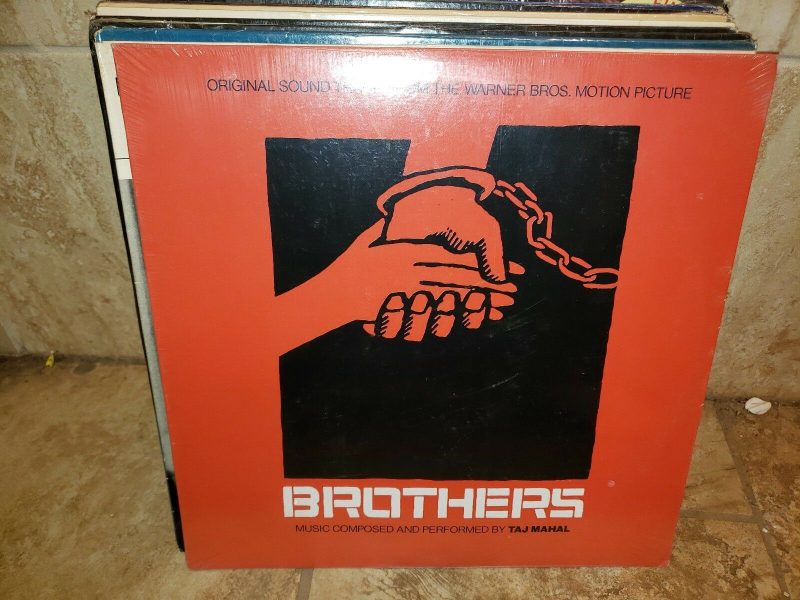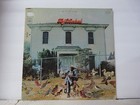Taj Mahal Vinyl Records Lps For Sale
Check out these new and used Taj Mahal vinyl records LPs for sale. We recommend starting your Taj Mahal vinyl collection with the essential albums Brothers, Satisfied ‘N Tickled Too and THE NATCH’L BLUES. Our inventory is always changing, so check back often, or browse our list of vinyl records for sale from blues musicians.
Auto Amazon Links: No products found. No products found.

Taj Mahal: A Musical Odyssey Across Time and Tradition
In the kaleidoscope of American music, the name Taj Mahal stands as a testament to the boundless possibilities of artistic exploration. Born Henry Saint Clair Fredericks on May 17, 1942, in Harlem, New York, Taj Mahal has woven an eclectic tapestry of sounds that transcend genres and eras. This article embarks on a journey through the life, influences, and musical legacy of the enigmatic and influential musician known as Taj Mahal.
Early Years and Musical Upbringing:
Taj Mahal’s early exposure to music was diverse, reflecting the vibrant cultural milieu of New York City. Raised in Springfield, Massachusetts, he soaked in the rich sounds of jazz, blues, Caribbean rhythms, and the gospel hymns of the Baptist church. It was in this melting pot of musical influences that Taj Mahal’s artistic roots began to take shape.
His family recognized his musical talents early on, and by the age of 13, Taj Mahal was already proficient in playing a variety of instruments, including the piano, clarinet, and harmonica. This early immersion in a multitude of musical styles would become the foundation for his later explorations and innovations.
The Birth of Taj Mahal:
In the early 1960s, as the American folk music revival was gaining momentum, Taj Mahal emerged as a young artist eager to contribute his unique voice to the evolving soundscape. Inspired by the likes of Sonny Terry and Brownie McGhee, Muddy Waters, and Howlin’ Wolf, he delved deep into the blues tradition, becoming a skilled guitarist, harmonica player, and vocalist.
The adoption of the name “Taj Mahal” was not only a nod to the iconic Indian monument but also a symbol of the multifaceted, transcendent quality that Taj sought to bring to his music. It was a name that hinted at the diverse array of influences that would come to define his career.
Blues at the Core:
At its core, Taj Mahal’s music is steeped in the blues, a genre that became the crucible for his artistic alchemy. His early albums, such as the self-titled “Taj Mahal” (1968) and “The Natch’l Blues” (1968), showcased his deep reverence for the Delta blues tradition. Songs like “Leaving Trunk” and “Statesboro Blues” not only paid homage to the blues greats who came before him but also demonstrated Taj Mahal’s ability to infuse the genre with his own distinctive flair.
Taj Mahal’s approach to the blues was dynamic and exploratory. He was not content to be a mere traditionalist; instead, he embraced the blues as a living, breathing entity that could absorb and reflect the myriad influences of the modern world. His keen sense of rhythm, soulful vocals, and intricate guitar work set him apart as a bluesman who transcended boundaries.
World Music Explorations:
While the blues formed the heart of Taj Mahal’s musical identity, his insatiable curiosity led him to explore a multitude of global sounds. In the late 1960s and early 1970s, he embarked on a journey that took him to the Caribbean, West Africa, and the Pacific Islands. This period of exploration culminated in albums like “Giant Step” (1969) and “Mozambique” (1975), where Taj Mahal seamlessly blended blues with reggae, calypso, and world music influences.
One of his most ambitious projects during this period was the soundtrack for the 1972 film “Sounder.” The score, a potent mix of blues and African-inspired melodies, earned Taj Mahal an Academy Award nomination and further showcased his ability to navigate diverse musical landscapes.
Roots and Branches: An Eclectic Discography:
Taj Mahal’s discography is a sprawling testament to his versatility and refusal to be confined by genre boundaries. Albums like “The Real Thing” (1971) and “Happy to be Just Like I Am” (1971) continued to showcase his mastery of the blues, while also incorporating elements of R&B, gospel, and soul.
As the 1970s progressed, Taj Mahal’s musical odyssey ventured into new territories. The albums “Mo’ Roots” (1974) and “Music Keeps Me Together” (1975) delved into reggae, funk, and Caribbean rhythms, signaling his ongoing commitment to embracing global sounds.
In the 1980s and beyond, Taj Mahal continued to surprise and delight audiences with a diverse array of albums. “Taj” (1987) marked a return to the blues, while “Shake Hands with the Devil” (1992) delved into the blues-rock genre. His collaborations with artists like Eric Clapton, B.B. King, and Ry Cooder further illustrated his ability to seamlessly integrate his sound with a wide array of musical luminaries.
Collaborations and Influence:
Taj Mahal’s collaborative spirit has been a defining aspect of his career. His willingness to engage with musicians from various backgrounds has not only enriched his own discography but has also contributed to the broader musical landscape. His collaboration with Ry Cooder on the Grammy-winning album “Taj Mahal and the Phantom Blues Band Live at St. Lucia” (2000) showcased the enduring vitality of his live performances.
Taj Mahal’s influence extends far beyond his recorded works. His impact on the blues, world music, and the broader spectrum of American music is immeasurable. His ability to seamlessly blend genres and draw inspiration from global sounds paved the way for future artists to explore the interconnectedness of musical traditions.
Awards and Recognition:
Taj Mahal’s contributions to music have not gone unnoticed by the industry. Over the course of his career, he has received multiple Grammy Awards, including those for Best Contemporary Blues Album and Best Country Collaboration with Vocals. In 2017, he was honored with the Americana Music Association’s Lifetime Achievement Award for Performance.
His induction into the Blues Hall of Fame in 2009 and the acknowledgment of his impact on the blues genre by the Rock and Roll Hall of Fame reflect the enduring significance of his contributions.
Legacy and Impact:
Taj Mahal’s legacy is a testament to the power of musical exploration and cross-cultural dialogue. His ability to weave together the strands of blues, reggae, Caribbean rhythms, and global sounds has left an indelible mark on the world of music. He is not merely a performer; he is a musical ambassador, bridging gaps and fostering a deeper understanding of the universal language of sound.
His impact on subsequent generations of musicians is evident in the eclectic nature of contemporary music. Artists across genres continue to draw inspiration from Taj Mahal’s ability to transcend labels and create a sound that is uniquely his own.
Conclusion: The Ever-Flowing River of Taj Mahal’s Music:
Taj Mahal’s musical journey is a testament to the infinite possibilities within the realm of sound. His ability to traverse genres, embrace cultural diversity, and infuse his music with authenticity has solidified his place as a musical luminary. From the smoky blues joints of the Mississippi Delta to the vibrant streets of the Caribbean, Taj Mahal’s music resonates as a celebration of the human experience.
As the ever-flowing river of Taj Mahal’s music continues to wind its way through the hearts and minds of listeners, it serves as a reminder of the power of art to transcend boundaries and unite people across the globe. In the intricate melodies of his guitar, the soulful resonance of his vocals, and the rhythmic heartbeat of his compositions, Taj Mahal’s music echoes through time, inviting us all to embark on a journey of exploration and discovery.
Taj Mahal Recycling The Blues & Other Related Stuff Vinyl LP1972 Columbia Blues
 | $15.00 Buy It on eBay for only: $15.00 Buy It Now on eBay |
LP-TAJ MAHAL-TAJ MAHAL -HQ- NEW VINYL
 | $40.74 Buy It on eBay for only: $40.74 Buy It Now on eBay |
Taj Mahal Lp Self - Titled On Columbia - Vg+/ Vg++
 | $33.99 Buy It on eBay for only: $33.99 Buy It Now on eBay |
Taj Mahal, Vinyl Records, Lot of 5, Early Pressings
 | $55.00 Buy It on eBay for only: $55.00 Buy It Now on eBay |
Taj Mahal Taj Mahal (Self-Titled) Columbia CS 9579 Stereo Vinyl Album LP VG
 | $15.00 Buy It on eBay for only: $15.00 Buy It Now on eBay |
Taj Mahal (Self-Titled S/T) LP FROM 1970 COMBINED SHIP USA Q
 | $23.99 Buy It on eBay for only: $23.99 Buy It Now on eBay |
Taj Mahal - The Natch'l Blues - Vinyl LP 1970 Columbia CS 9698 VG+/VG+
 | $29.99 Buy It on eBay for only: $29.99 Buy It Now on eBay |
Taj Mahal Self-Titled Vinyl CS 9579, 1970's Reissue Pittman Pressing VG Cond
 | $19.79 Buy It on eBay for only: $19.79 Buy It Now on eBay |
TAJ - TAJ MAHAL LP EXCELLENT CONDITION RARE GREAT MUSIC EVERYBODY IS SOMEBODY
 | $6.99 Buy It on eBay for only: $6.99 Buy It Now on eBay |
Taj Mahal - S/T - Vinyl Lp - Terre Haute Pressing - Columbia CS 9579 - Blues
 | $70.00 Buy It on eBay for only: $70.00 Buy It Now on eBay |
Taj-Mahal Travellers JULY 15, 1972 LP Vinyl Re-Issue Iskra Takehisa Kosugi NEW
 | $19.99 Buy It on eBay for only: $19.99 Buy It Now on eBay |
Taj Mahal Oooh So Good 'n Blues Lp VG 1977 Columbia KC32600
 | $6.50 Buy It on eBay for only: $6.50 Buy It Now on eBay |
Taj Mahal Giant Step/De Ole Folks At Home 2 LP Vinyl Record Gatefold Set VG
 | $5.99 Buy It on eBay for only: $5.99 Buy It Now on eBay |
THE TAJ MAHAL ANTHOLOGY VOLUME 1 COLUMBIA VINYL LP VG+ RECORD
 | $41.60 Buy It on eBay for only: $41.60 Buy It Now on eBay |
Taj Mahal Oooh So Good n Blues 1973 Columbia KC 32500 NM/VG+ Delta Blues Vintage
 | $19.95 Buy It on eBay for only: $19.95 Buy It Now on eBay |
Taj Mahal Music Fuh Ya Musica Para Tu Lp 1977 Near Mint Record EX Cover
 | $4.99 Buy It on eBay for only: $4.99 Buy It Now on eBay |
Taj Mahal - Giant Step / De Ole Folks At Home (2xLP, Album, RE, Pit) (Very Good
 | $10.75 Buy It on eBay for only: $10.75 Buy It Now on eBay |
TAJ MAHAL WHY DID YOU HAVE TO DESERT ME 45 7" NM US COLUMBIA PROMO VINYL SOUL
 | $5.98 End Date: Monday Dec-22-2025 17:00:01 EST Buy It on eBay for only: $5.98 Buy It Now on eBay |
TAJ MAHAL & RY COODER - GET ON BOARD - VINYL LP " NEW, SEALED "
 | $24.98 Buy It on eBay for only: $24.98 Buy It Now on eBay |
Taj Mahal - Hidden Treasures Of Taj Mahal (1969-1973) - Limited 180-Gram Clear &
 | $32.12 Buy It on eBay for only: $32.12 Buy It Now on eBay |

![The Life of a Showgirl[Sweat & Vanilla Perfume Orange Glitter Vinyl] #1](https://m.media-amazon.com/images/I/51SJhJbv35L._SL100_.jpg)
![The Life of a Showgirl[Sweat & Vanilla Perfume Orange Glitter Vinyl] #2](https://m.media-amazon.com/images/I/5198D2rwyNL._SL100_.jpg)


![Merry Christmas II You [15th Anniversary Shiny Starlight LP] [Amazon Exclusive] #1](https://m.media-amazon.com/images/I/51MOyCwkOzL._SL100_.jpg)

![Currents [2 LP] #1](https://m.media-amazon.com/images/I/61zjlISscDL._SL100_.jpg)
![Currents [2 LP] #2](https://m.media-amazon.com/images/I/51ETyCkBSyL._SL100_.jpg)













![[Exquisite Appearance] Built from wood and metal materials with a unique sense of layering; The streamlined corner design is truly atmospheric and stylish(Note: long hold the start button to turn the power on, and press again to start) [All in 1] Thi...](https://m.media-amazon.com/images/I/41vovGjFkeL._SL160_.jpg)





































